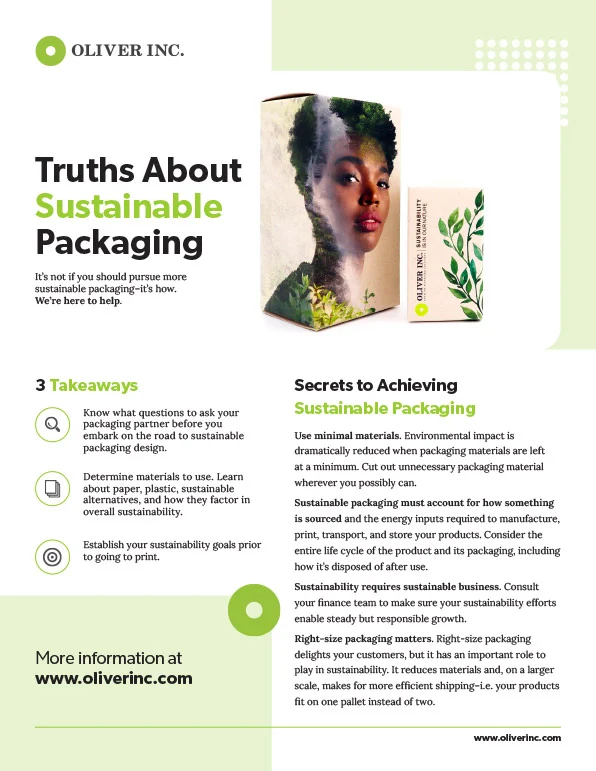What Materials Are Used in Frozen Food Packaging?
Posted by Oliver Inc. on 5th Aug 2022
Frozen food packaging must prioritize food quality and safety. And that begins with selecting the proper substrates.
Your packaging materials have to keep food fresh while remaining leak proof and durable. Plus, they must be grease resistant and able to tolerate extreme temperature changes.
Fortunately, there are several food packaging options available that help frozen food brands meet a variety of other business goals, including sustainability.
Frozen Food Packaging Materials
From petroleum-based products such as shrink wrap and individually quick frozen (IQF) polyethylene to cardboard and aluminum, frozen food packaging comes in a wide variety of materials. While some are more sustainable than others, each has its benefits.
Let’s consider a few of the more common substrate options.
Coated Natural Kraft (CNK) Paperboard
Reinforced with a coating to preserve the integrity of food against the wear and tear of the thawing process, CNK paperboard is a hardy but adaptable substrate. CNK is constructed from softwood fibers that provide superior strength and protection, whether products are refrigerated or frozen.
Its surface layer consists of hardwood fibers and clay-based coating that’s optimal for printing. CNK’s burnished, glossy surface is ideal for sophisticated graphic designs and decorative effects whose integrity won’t be compromised by exposure to extreme temperature changes or condensation.
CNK’s low-caliper construction enables it to retain rigid shape at lower weight than similar substrates—thus reducing cost.
If you’re looking for a material whose structure is wildly adaptable, CNK is a great choice. It can easily accommodate windowing and other advanced custom designs.
Solid Bleached Sulfate (SBS) Paperboard
Consisting of a whitened chemical pulp derived from virgin timber, SBS is a medium-density material option well suited for printing. Like CNK, it is clay coated to preserve the integrity of both the food and packaging.
SBS also has the advantage of accommodating embossing, foil stamping, and creasing while withstanding extremely cold freezer temperatures. Their eye-catching visual designs help these products stand out in the frozen food section.
Poly-Coated Paperboard
For products that require direct contact with food and a grease barrier, poly-coated substrates are very effective. They are a popular food packaging choice because they're also heat resistant, a much sought-after feature for microwaved products.
Notably, poly-coated paperboard is not recyclable, which gives environmentally conscious brands some reason to pause when considering it as a frozen food packaging material.
Other materials for frozen food packaging include shrink wrap and aluminum.
Shrink wrap is a heat-sealed film that quickly covers and protects a product. It’s worth noting shrink wrap is petroleum based. If you’re an environmentally friendly brand, you may want to consider other more renewable alternatives, if not at least being judicious with how much shrink wrap you use in frozen food packaging.
Frequently formatted as trays for frozen food, aluminum is often used to package casserole dishes, lasagna, and complete meals. Aluminum is considered food-grade material by the U.S. Department of Agriculture, as well. It has the added benefit of recyclability, however, that requires cleaning residual food off the aluminum before recycling, which some consumers may not be willing to do.
Sustainability in Frozen Food Packaging
Put simply, more consumers are looking for food brands that help them make sustainable purchases. According to an October 2021 report from marketing insights resource Think With Google, 82% of consumers place a high priority on sustainability.
So what does that mean for frozen food packaging?
In addition to practicing right-size packaging principles, localizing supply chains, and limiting their carbon footprint, frozen food brands can achieve their sustainability goals by implementing a few sustainable substrate alternatives into their packaging solutions.
Post-Consumer Recycled Paperboard
By integrating post-consumer recycled paperboard into packaging (and signifying it on the label), you communicate to consumers your commitment to sustainability while enjoying the packaging benefits of paperboard.
Bio-Polymers
Biodegradable protein alternatives, such as casein, are sustainable and many magnitudes greater at keeping out oxygen and other contaminants compared to petroleum-based plastic wraps. They are extracted from biomass and synthesized, providing brands with a sustainable option that avoids the landfill.
Your food stays fresh longer while reinforcing your brand as a leader in sustainability.
Working With an SQF-Certified Packaging Manufacturer
Some food printing and packaging manufacturers are more committed to food safety than others. To be confident your packaging partner maintains the highest global health and safety standards, collaborate with one that is Safe Quality Food (SQF) certified.
Recognized by the Global Food Safety Initiative (GFSI), the SQF certification accounts for everything relating to industry, customer, and regulatory requirements and entails every aspect of the supply chain.
SQF safety categories include primary production, food retail, manufacturing, food packaging, storage and distribution, and quality.
Ultimately, there are many packaging solutions available, which can be rather daunting.
So, whether your brand emphasizes sustainability or goes a more traditional, frozen food packaging route, you’ll want to consult an experienced printing and packaging partner. They’ll ensure you combine the proper blend of substrates, adhesives, and decorative effects capable of withstanding extreme temperature changes, condensation, and a variety of storing conditions.






